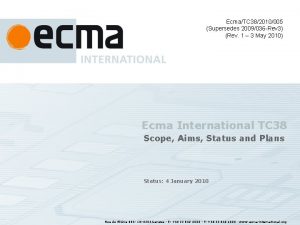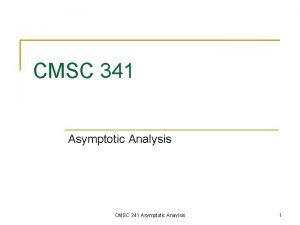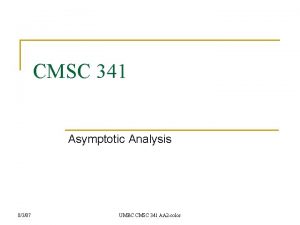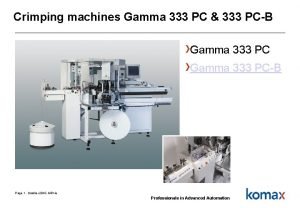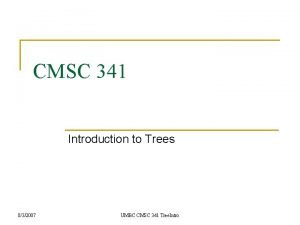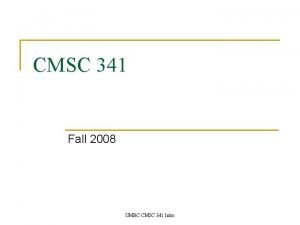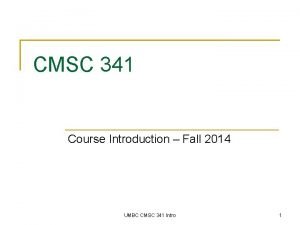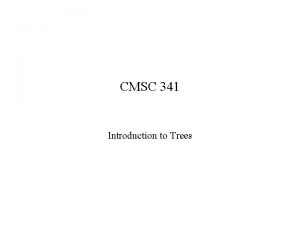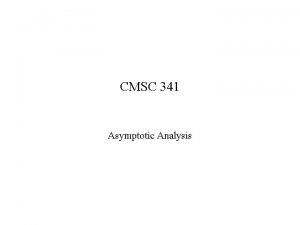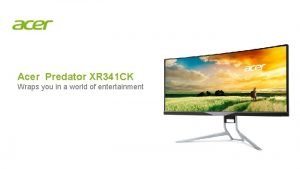King Saud University College of Engineering IE 341































- Slides: 31

King Saud University College of Engineering IE – 341: “Human Factors” Fall – 2015 (1 st Sem. 1436 -7 H) Visual Displays of Dynamic Information (Chapter 5) 1

Lesson Overview • Uses of Dynamic Information • Quantitative Visual Displays • Qualitative Visual Displays 2

Uses of Dynamic Information • Dynamic information: i. e. changing info; e. g: o o Natural phenomena (e. g. temperature, pressure) Vehicle speed Traffic lights Frequency, intensity of sounds, etc. • Dynamic displays: o Displays used to display dynamic information o Types of dynamic displays, type of info. presented: • Quantitative: precise numeric value of some variable (e. g. “pressure is 125 psi”) • Qualitative: approximate value/rate of change/change in direction (e. g. “pressure is increasing”) • Status/check: determines if readings are normal (e. g. “pressure is normal”) • Representational: situation awareness; e. g. radar display predicts where plane will be in 5 or 10 minutes 3

Quantitative Visual Displays • Types of variables in QVD’s: o Changing/dynamic variables (e. g. temp. , pressure) o Static variables (rare): length, weight of objects • Basic Design of Quantitative Displays o Mechanical displays (see next slide) • Fixed scale with moving pointer (analog): a-e • Moving scale with fixed pointer (analog): f-i • Digital display: j o Electronic displays (see slide 6) • Analog scales: k, l • Digital scale: m 4

Mechanical Displays 1. Analog Displays 2. Digital Display 5

Electronic Displays 1. Analog Displays 2. Digital Display 6

Cont. Quantitative Visual Displays Comparison of Different Designs (Studies) • Digital displays preferred vs. analog when: 1. a precise numeric (quantitative) value is required 2. values shown remain visible long enough to be read (i. e. not continuously changing) • Analog displays preferred vs. digital when: o fixed-scale moving-pointer displays: useful when the values change frequently /continuously ⇒ limited time in reading values if digital displays were used o when important to know direction or rate of value change (qualitative reading) 7

Cont. Quantitative Visual Displays Cont. Comparison of Different Designs • Fixed scale w/ moving pointer vs. moving scale w/ fixed pointer 1. 2. Generally: fixed scale is preferred vs. moving scale If numerical increase is related to another natural interpretation (e. g. more or less, up and down): • easier to interpret straight line (horizontal or vertical scales) or thermometer scale with a moving pointer • pointer position relative to zero/null adds value 3. Don’t mix different types of pointer-scale indicators when used for related functions • this avoids reversal errors in reading 4. Direction of moving element is clearer if manual control moves pointer (rather than scale) 5. For slight variable movements/changes in quantity ⇒ more clear if a moving pointer is used 8

Cont. Quantitative Visual Displays Cont. Comparison of Different Designs • Moving scale w/ fixed pointer vs. fixed scale w/ moving pointer 1. Moving scale preferred (due to small panel space) when range of values: too great to show on small scale; e. g. : • moving rectangular open-window scales • moving horizontal and vertical scales 2. Also when a numerical value is needed to be readily available, a moving scale appearing in an open window can be read more quickly (which ? ) • Circular/Semicirc. scales vs. vertical/horizontal o Circular/Semicirc. Scales generally preferred (a, b, c) o Vertical/horizontal preferred (d, e) when relating to null or viewing more/less, up/down (see slide 8) 9

Cont. Quantitative Visual Displays: Basic Features of Quantitative Displays • Scale range: o Numerical difference bet. highest & lowest values on scale • Numbered interval: o Numerical difference bet. adjacent #’s on scale • Graduation interval: o Numerical difference bet. smallest scale markers • Scale unit o Smallest unit to which scale is to be read (note, not necessarily = graduation interval) 10

Cont. Quantitative Visual Displays Specific Features of Conventional Quant. Displays • Ability of people to make visual discriminations in QVD’s is influenced by the following specific features: 1. 2. 3. 4. 5. 6. 7. Numeric Progressions of Scales Length of Scale Unit Design of Scale Markers and Interpolation Design of Pointers Combining Scale Features Scale Size and Viewing Distance • Note, above features discussed here for mechanical scales, yet much of this applies also to electronic displays 11

Cont. Quantitative Visual Displays Specific Features of Conventional Quant. Displays 1. Numeric Progressions of Scales • Every quantitative scale has numeric progression system, including o Graduation interval: bet. adjacent markers o Numbered interval: major scale markers • Number progressions: o Progression by 1 s (0, 1, 2, 3, …) is easiest to use: • Major markers: 0, 10, 20, 30, …. , • with intermediate markers: 5, 15, 25, 35, …. , • with minor markers at individual numbers o Progression by 5 is also satisfactory o Progression by 25 is moderate. • Decimals make scales more difficult to use: o If used, zero before decimal should be omitted • Unusual progressions (3 s, 8 s etc): avoid 12

Cont. Quantitative Visual Displays Specific Features of Conventional Quant. Displays 2. • Length of Scale Unit Defn: length on scale representing smallest numeric value to which the scale is to be read o e. g. force is to be measured to nearest 10 Newtons, o On scale: 10 N is to correspond to 1. 3 mm o ⇒ length of scale unit = 1. 3 mm • length of scale unit should allow distinctions between values with optimum reliability in terms of human sensory & perceptual skills: o research suggests values between: 1. 3 - 1. 8 mm o Larger values are needed when instruments are used in non-ideal conditions • e. g. low vision, poor illumination, limited time, etc) 13

Cont. Quantitative Visual Displays Specific Features of Conventional Quant. Displays 2. Cont. Length of Scale Unit • recom. format for quantitative scale given length of scale unit (? ), graduation markers 14

Cont. Quantitative Visual Displays Specific Features of Conventional Quant. Displays 3. Design of Scale Markers • recommended to include a scale marker for each scale unit to be read • Conventional progression scheme (last slide), based on: o Major markers: 1, 100, etc. o minor markers: 0. 1, 1, 10, etc. (example? ) 4. Scale Markers and Interpolation • If scales: much compressed (>last slide) ⇒ scale markers: crowded ⇒ reading accuracy ↓ o Such case: use a scale requiring interpolation o Interpolation: estimation of values between markers • For high accuracy reading of scale: o marker should be placed at every scale unit o Requires: a larger scale or a closer viewing distance 15

Cont. Quantitative Visual Displays Specific Features of Conventional Quant. Displays 5. Design of Pointers • Recommendations for pointer design: o o pointed pointers (tip angle of about 20°) have the pointer tip meet, but not overlap, the smallest scale markers have the color of the pointer extend from the tip to the center of the scale have the pointer close to the surface of the scale to avoid parallax (see below) 16

Cont. Quantitative Visual Displays Specific Features of Conventional Quant. Displays 6. Combining Scale Features • mentioned features of quantitative scales: are integrated into relatively standard formats o e. g. slide 14: used for circular, semi-circular scales • Note, above features: only general (non-rigid) guidelines • e. g. ’s of poor scale designs: o Ampere scale: • Shortness of scale units • Inadequate intermediate markers o Kilowatt scale (left): • Name 5 corrections? 17

Cont. Quantitative Visual Displays Specific Features of Conventional Quant. Displays 7. Scale Size and Viewing Distance • previous guidelines: for normal viewing distance: 28 in. (71 cm) • If display viewed from farther distances ⇒ o features have to be enlarged to maintain the same visual angle (VA) at the eye • To maintain same VA for any viewing distance x: use this formula to find proper dimension : o Dimension at x [in] = Dimension @ 28 in * (x [in] / 28) o Example: find @ 100 cm from scale (viewed in normal viewing conditions): • Minimum length of scale unit • VA • Minimum Snellen acuity required to read scale 18

Qualitative Visual Displays • Objective of displays used for qualitative info: o Approx. value of continuously changing variable • e. g. pressure, temperature, speed, etc. o Rate of change/change in direction of variable • Quantitative basis of Qualitative Reading 1. Determining status/condition of variable in terms of specific predetermined range(s) • e. g. gauge of engine: cold, normal, or hot 2. Maintain a desirable range of approximate values • e. g. speed range between 50 -55 mph (80 -88 kmh) 3. Observing trends/rates of change • e. g. airplane ascending or descending; or N, S, E, W 19

Cont. Qualitative Visual Displays • Cont. Quant. Basis of Qualitative Reading o Note, scales best applicable for quant. task not necessarily best applicable for qualit. task (below) o Can you analyze table below? 20

Cont. Qualitative Visual Displays Design of Qualitative Scales • Values: sliced into limited number of ranges • Coding for ranges/readings on qualit. scales: 1. 2. Color codes for ranges (right) Shape coding for specific ranges of values • advise: take advantage of natural compatible associations people have bet. coding features and intended meanings 21

Cont. Qualitative Visual Displays Cont. Design of Qualitative Scales 2. Cont. Shape coding o • • Experiment conducted: Purpose: determine best association between shapes and meaning of different military plane readings 140 subjects 7 shapes vs. 7 meanings %ge correct responses shown in ( ) 22

Cont. Qualitative Visual Displays Cont. Design of Qualitative Scales • Use of strictly Quantitative displays: o involves identifying quantitative value, and o involves assigning value read to one of possible ranges of values that represent the categories • Use of strictly Qualitative displays o directly conveys meaning of display indicator • Use of Quantitative + Qualitative displays: o Indicate trend, direction, rate of change (qualit. ) o Indicate also: quant. reading (if values included) o Examples: • Last slide • Car speed gauge (numbers + indication at 120 kmh) • Other examples? 23

Cont. Qualitative Visual Displays Check Reading • instrument that checks if reading is normal • this is achieved using quant. scale • normal condition is represented by an exact or very narrow values (not range) o e. g. to determine if voltage is ~110 V or ~220 V • requires caution to display normal reading clearly • research suggests normal reading should be aligned (for circular scales) at: o 9 o’clock position (next slide) o 12 o’clock position (also acceptable) 24

Cont. Qualitative Visual Displays Cont. Check Reading • when several check reading devices used ⇒ deviant device should stand out (see below) • “gestalt”: human tendency to perceive complex configuration as complete entity o ⇒ odd entity becomes immediately clear o e. g. below: lines between dials adds to “gestalt” o lower configuration also acceptable (less clear) 25

Cont. Qualitative Visual Displays Status Indicators • Qualitative info. can indicate status of system o e. g. check reading: normal or abnormal o e. g. automobile thermometer: cold/normal/hot • status indicators: show –only- separate, discrete conditions (comp. to check reading) o e. g. on/off o e. g. traffic lights: stop/caution/go • Note, scales that show only check reading can be converted to status indicators • Common uses: o light indicators (varying color, position) • e. g. traffic lights: red (top), yellow (middle), green (bot. ) o also used with stove controls (on/off) 26

Cont. Qualitative Visual Displays Signal and Warning Lights • Flashing/steady state lights used for: o o Warning (e. g. highways) Identification (e. g. aircrafts at night) Navigation aids, beacons Attracting attention (e. g. on instrument panel) • Factors affecting detectability of lights 1. 2. 3. Size, Luminance, and Exposure time Color of Lights Flash Rate of Lights 27

Cont. Qualitative Visual Displays Cont. Signal and Warning Lights 1. Size, Luminance, and Exposure Time • Detecting flashing light depends on combinon: size, luminance, exposure time o as size of light ↑ and/or as exposure time ↑ ⇒ luminance required to just detect light ↓ o “just detect”: can be detected 50% of the time (i. e. luminance threshold) o for operational use: • luminance should be at least double these to be detected 99% of the time 28

Cont. Qualitative Visual Displays Cont. Signal and Warning Lights 2. Color of Lights • background color + ambient illumination ⇒ o influence ability of people to detect and respond to lights of different colors • With good signal brightness contrast + dark background o color has minimal importance in attracting attention • With low signal-to-background brightness contrast: o red signal is recommended, o followed by green, yellow, and white 29

Cont. Qualitative Visual Displays Cont. Signal and Warning Lights 3. Flash Rate of Lights • flash rate should be « 30 times/sec • ≥ 30 ⇒ light appears steady ⇒ “flicker-fusion” • Recommended to attract attention, use: o flash rates of about 3 -10 per second o duration of at least 0. 05 s • Recommended for highways and flyways, use: o 60 -120 flashes per minute (1 -2 per second) • Varying flashing lights o mostly: single/fixed flashing light used o some applications: lights with different flash rates • e. g. tail lights showing rate of deceleration: car brakes • Keep in mind: humans can differentiate -maximum of- three different flash rates clearly (remember: JND ? ) 30

o o References Human Factors in Engineering and Design. Mark S. Sanders, Ernest J. Mc. Cormick. 7 th Ed. Mc. Graw: New York, 1993. ISBN: 0 -07 -112826 -3. Slides by: Dr. Khaled Al-Saleh; online at: http: //faculty. ksu. edu. sa/alsaleh/default. aspx 31
 King saud university college of medicine
King saud university college of medicine King saud university college of medicine
King saud university college of medicine King saud university college of medicine
King saud university college of medicine King saud university college of pharmacy
King saud university college of pharmacy King saud university college of medicine
King saud university college of medicine King saud university college of pharmacy
King saud university college of pharmacy King saud university college of pharmacy
King saud university college of pharmacy King saud university college of business administration
King saud university college of business administration Ksu mechanical engineering
Ksu mechanical engineering King saud university riyadh
King saud university riyadh King saud university hospital nurse salary
King saud university hospital nurse salary College of engineering, king abdulaziz university
College of engineering, king abdulaziz university Dr saud
Dr saud 沈榮麟
沈榮麟 Sda hymn 341
Sda hymn 341 Ecma-341
Ecma-341 Cmsc 341
Cmsc 341 Umbc cmsc 341
Umbc cmsc 341 346 rounded to the nearest hundred
346 rounded to the nearest hundred Pc 333
Pc 333 Cmsc 341
Cmsc 341 Umbc cmsc 341
Umbc cmsc 341 Cmsc 341
Cmsc 341 Jump instruction
Jump instruction Cmsc 341
Cmsc 341 341 ces
341 ces Cmsc 341
Cmsc 341 Ck wraps
Ck wraps Oui par ton sang lave mon coeur
Oui par ton sang lave mon coeur Mgmt 341
Mgmt 341 Ncg 341
Ncg 341 Cs 341
Cs 341















